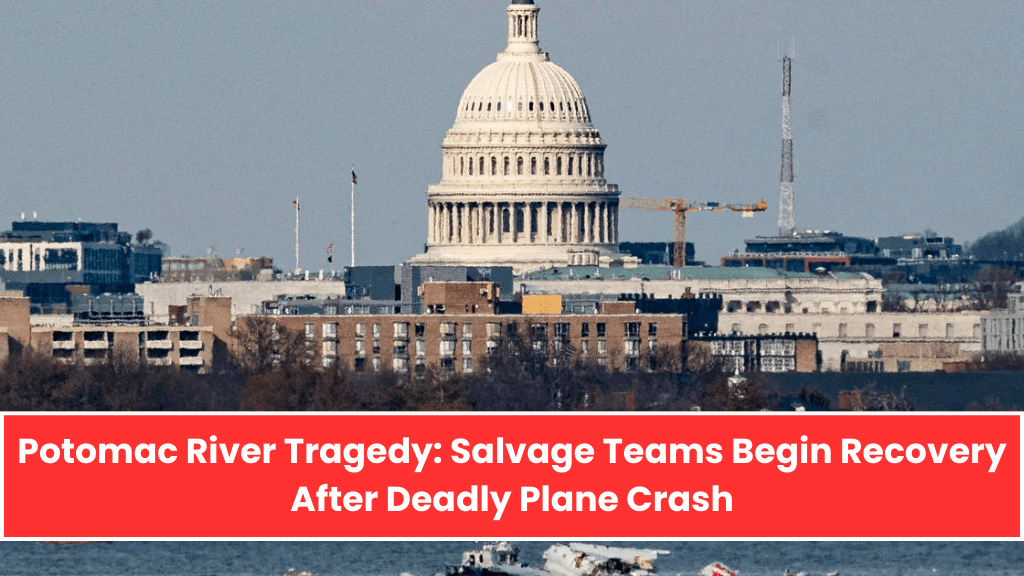A devastating midair collision involving an American Airlines jet and a U.S. Army Black Hawk helicopter over the Potomac River near Reagan Washington National Airport resulted in the deaths of 67 people on Wednesday night.
The National Transportation Safety Board (NTSB) has begun its investigation into the tragedy while recovery efforts continue.
What Happened: A Collision Between Jet and Helicopter
On Wednesday night, American Airlines Flight 5342 collided with a Black Hawk helicopter conducting a training mission. The collision occurred over the Potomac River, leading to the deaths of everyone on board both aircraft.
According to NTSB board member Todd Inman, preliminary data shows that the American Airlines jet was flying at an altitude of 325 feet, plus or minus 25 feet. The Black Hawk helicopter, based on air traffic controller monitors, was at approximately 200 feet—the maximum allowed altitude for helicopters near Reagan National Airport.
Investigators have determined that the crew of the airplane attempted to gain altitude moments before the collision.
NTSB investigator Brice Banning stated that at 8:47:58 p.m., the crew had a verbal reaction, and data from the flight data recorder (FDR) showed the plane increasing its pitch. However, the impact occurred moments later, with the collision sounds recorded by the FDR.
Challenging Airspace and Night Vision Considerations
The Black Hawk helicopter was performing a night training mission, and investigators are examining whether the crew was using night vision goggles (NVGs) during the flight.
Inman explained that NVGs can reduce a pilot’s field of vision and may have played a role in the collision. Bill Pearce, a commercial pilot from Maryland, highlighted that flying into Reagan National Airport presents unique challenges.
The airport’s location near restricted airspace and landmarks, such as the National Mall, requires precise navigation. Pilots landing on Runway 19 must follow the Potomac River’s narrow flight path, leaving little room for error.
Pearce noted that given the complexity of the airspace, the NTSB will likely focus on both altitude and communication during its investigation.
Ongoing Recovery Operations
Efforts to recover the wreckage began immediately after the crash, led by the U.S. Army Corps of Engineers Baltimore District, the U.S. Coast Guard, and the U.S.
Navy’s Supervisor of Salvage and Diving. Recovery operations will first focus on removing debris from the American Airlines jet, which is expected to take three days.
Once the jet is fully recovered, the team will turn its attention to the wreckage of the Black Hawk helicopter. The recovery of all large debris is expected to be completed by February 8, followed by additional cleanup of smaller debris by February 12.
Baltimore District Commander Col. Francis Pera praised the coordination of the recovery efforts, emphasizing the focus on safety and the importance of providing closure to the families of the victims.
What We Know So Far
The collision occurred at 8:47 p.m. on Wednesday night. Preliminary reports indicate that the American Airlines jet was flying at approximately 325 feet, while the Black Hawk helicopter was at about 200 feet.
The flight ceiling for helicopters in that airspace is 200 feet, which has raised questions about potential altitude violations and communication breakdowns. The crash resulted in the deaths of 67 people, with 42 victims recovered from the water as of Saturday.
Investigators have not ruled out other factors and are currently analyzing data from the FDR, cockpit voice recorders, and radar systems to reconstruct the events leading to the crash.
Challenges of Navigating Reagan National’s Airspace
Reagan National Airport is known for its challenging airspace due to its proximity to restricted areas, such as the White House and Capitol. Aircraft approaching from the north must follow a narrow corridor along the Potomac River to avoid entering prohibited zones.
Pilots often describe flying into the airport as demanding, especially with the high volume of air traffic that includes both civilian and military flights.
Pearce pointed out that the combination of restricted airspace, narrow flight paths, and varying altitude requirements could have contributed to the tragic collision.
Looking Ahead: Key Focus Areas for Investigators
The NTSB is focusing on several key aspects of the crash, including the overlapping altitudes of the two aircraft and possible communication lapses.
Investigators are also analyzing whether the Black Hawk’s use of night vision goggles may have impaired the crew’s visibility. Additionally, flight path deviations and air traffic control communications will be examined to determine whether proper protocols were followed.
Community Impact and Support
The collision has had a significant impact on both the aviation community and local residents. Families of the victims are being provided support, and recovery teams are working to safely clear the wreckage from the Potomac River and surrounding areas.
Officials have asked residents to avoid the crash site and to report any debris they may find. The community is mourning the loss of 67 lives, with many hoping the investigation will provide answers and prevent future tragedies.
As the investigation continues, officials hope to uncover the cause of this tragic midair collision to prevent similar incidents in the future.
The aviation community and the families of the victims await the NTSB’s final report, which will shed light on what went wrong during the flight and how such disasters can be avoided.
